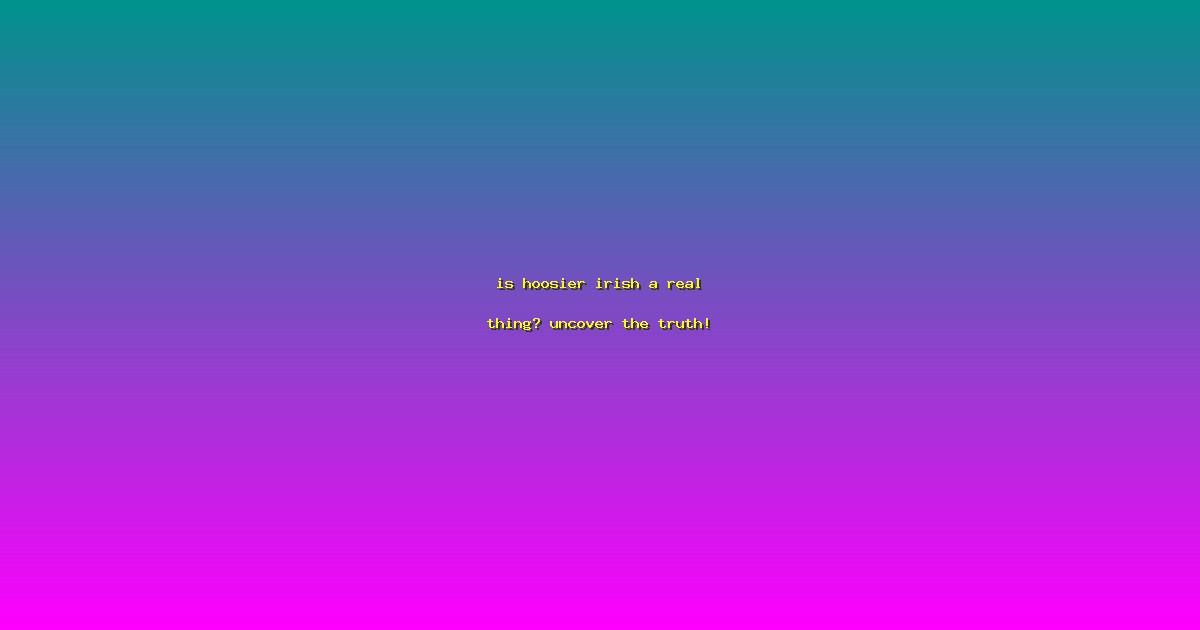is hoosier irish a real thing? uncover the truth!
Have you ever heard someone refer to themselves as “Hoosier Irish” and wondered what it means? The term “Hoosier Irish” is a unique blend of cultural identity that has deep roots in the history of Indiana. This article will delve into the origins, significance, and the stories behind this intriguing term. Whether you’re a history buff, a curious Hoosier, or just someone interested in cultural identities, this exploration of “Hoosier Irish” will provide you with a fascinating look into a lesser-known aspect of American heritage.
The Origins of “Hoosier Irish”
The term “Hoosier Irish” refers to individuals of Irish descent who have settled in the state of Indiana. The history of Irish immigration to Indiana is rich and complex, with many Irish immigrants arriving in the mid-19th century, particularly during and after the Great Famine in Ireland. These immigrants brought with them their cultural traditions, religious practices, and a strong sense of community, which they integrated into the fabric of Indiana’s society.
- Historical Context: The Great Famine in Ireland, which lasted from 1845 to 1849, led to mass emigration, with many Irish families seeking new opportunities in the United States. Indiana, with its growing industrial and agricultural sectors, became a popular destination for these immigrants.
- Community Formation: Irish immigrants in Indiana often settled in close-knit communities, forming their own neighborhoods and establishing churches, schools, and social clubs. This helped preserve their cultural identity while integrating into the broader Hoosier community.
- Expert Insight: According to Dr. Michael McGovern, a historian specializing in Irish-American history, “The term ‘Hoosier Irish’ reflects the unique blend of Irish heritage and Hoosier identity that emerged in Indiana. It’s a testament to the resilience and adaptability of the Irish immigrants who settled there.”
The Cultural Impact of “Hoosier Irish”
The cultural impact of “Hoosier Irish” is evident in various aspects of Indiana’s society, from its cuisine to its festivals and traditions. The Irish influence has left an indelible mark on the state, contributing to its rich cultural tapestry.
- Culinary Traditions: Irish dishes such as corned beef and cabbage, shepherd’s pie, and soda bread have become staples in many Hoosier households. These foods are often featured at local festivals and community events, celebrating the Irish heritage of Indiana.
- Festivals and Celebrations: St. Patrick’s Day celebrations in Indiana are a testament to the enduring influence of Irish culture. Cities like Indianapolis, South Bend, and Evansville host vibrant parades, music, and dance performances that showcase the “Hoosier Irish” spirit.
- Practical Application: Understanding the cultural impact of “Hoosier Irish” can help foster a deeper appreciation for the diverse heritage that shapes Indiana’s identity. By embracing these traditions, Hoosiers can celebrate their shared history and build stronger, more inclusive communities.
The Modern “Hoosier Irish” Identity
Today, the term “Hoosier Irish” continues to resonate with many individuals who trace their ancestry back to Ireland. This identity is not just a matter of heritage but also a way of life that combines the best of both worlds.
- Case Study: The city of Terre Haute, Indiana, has a significant “Hoosier Irish” population. The local St. Patrick’s Day parade and the annual Irish Festival are prime examples of how this identity is celebrated and preserved.
- Expert Quote: “The ‘Hoosier Irish’ identity is a beautiful fusion of two distinct cultures,” says Dr. Sarah O’Connor, a cultural anthropologist. “It’s a testament to the enduring legacy of Irish immigrants and their descendants in Indiana.”
- Implementation Steps: To embrace and celebrate your “Hoosier Irish” identity, consider participating in local Irish cultural events, learning about Irish history and traditions, and connecting with local Irish-American organizations.
Frequently Asked Questions
What does “Hoosier Irish” mean?
The term “Hoosier Irish” refers to individuals of Irish descent who have settled in the state of Indiana. It reflects a unique blend of Irish heritage and Hoosier identity, highlighting the cultural contributions of Irish immigrants to Indiana’s society.
How did Irish immigrants impact Indiana?
Irish immigrants played a significant role in shaping Indiana’s economy, culture, and social fabric. They contributed to the state’s industrial and agricultural growth, established influential communities, and brought their rich cultural traditions to Indiana.
Are there any notable “Hoosier Irish” figures?
Yes, there are many notable “Hoosier Irish” figures who have made significant contributions to Indiana. For example, Eugene V. Debs, a prominent labor leader and political figure, was of Irish descent and played a crucial role in the labor movement in Indiana.
Is “Hoosier Irish” still relevant today?
Absolutely. The “Hoosier Irish” identity remains relevant today, as many Hoosiers proudly embrace their Irish heritage. This identity is celebrated through cultural events, festivals, and community gatherings, ensuring that the legacy of Irish immigrants continues to thrive.
How can I learn more about “Hoosier Irish” history?
To learn more about “Hoosier Irish” history, visit local museums, libraries, and historical societies. Many communities in Indiana have resources and exhibits dedicated to the history and contributions of Irish immigrants. Additionally, attending local Irish cultural events can provide firsthand insights into this unique identity.
Conclusion
The term “Hoosier Irish” is more than just a label; it’s a testament to the enduring legacy of Irish immigrants in Indiana. By understanding and celebrating this unique identity, we can foster a deeper appreciation for the rich cultural tapestry that makes Indiana what it is today. Whether you’re exploring your own heritage or simply interested in the history of Indiana, the story of the “Hoosier Irish” is one worth uncovering. So, embrace the “Hoosier Irish” spirit and join the celebration of this vibrant cultural legacy.
